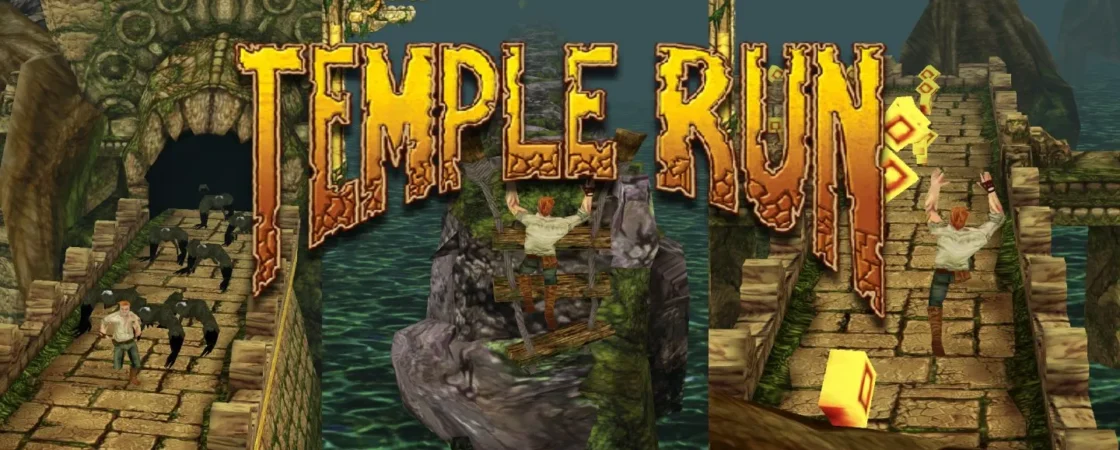In the world of mobile gaming, few titles have achieved the iconic status of Temple Run. Launched in 2011 by Imangi Studios, this endless runner quickly became a sensation, captivating players with its thrilling gameplay and engaging mechanics. The game’s premise is simple yet addictive: players control an explorer fleeing from demonic monkeys while navigating a treacherous temple filled with obstacles. But what is it about Temple Run that has allowed it to remain relevant for over a decade? This article explores the game’s origins, gameplay mechanics, cultural impact, and why it continues to be a beloved favorite among gamers.
The Origins of Temple Run
Temple Run was conceived by husband-and-wife duo Keith Shepherd and Natalia Luckyanova, along with designer Kiril Tchangov. The inspiration for the game came from their love of action-adventure films and the thrill of exploration. They wanted to create a mobile game that captured the excitement of running through an exotic environment while dodging obstacles.
Initially released for iOS, Temple Run’s combination of intuitive swipe controls, stunning graphics, and an engaging premise quickly caught the attention of gamers. Within months, it had amassed millions of downloads, paving the way for various updates, sequels, and spin-offs.
Gameplay Mechanics
At its core, Temple Run features simple yet effective gameplay mechanics that contribute to its addictive nature. Players control a character who automatically runs forward through a series of winding paths. The objective is to navigate this treacherous landscape while collecting coins, power-ups, and bonuses, all while avoiding obstacles and the pursuing monkeys.
Controls
The controls are primarily swipe-based, which makes the game accessible to players of all ages. Here’s a breakdown of the main actions:
- Swipe Left or Right: To turn corners and change lanes.
- Swipe Up: To jump over obstacles such as fire pits and gaps in the path.
- Swipe Down: To slide under barriers, avoiding detection by the chasing monkeys.
These intuitive controls make Temple Run easy to pick up, yet difficult to master, resulting in a game that encourages repeated play.
Power-Ups and Bonuses
As players run through the temple, they can collect coins and power-ups. Coins can be used to purchase upgrades, new characters, and other enhancements. Power-ups include:
- Coin Magnet: Attracts coins towards the player for a limited time.
- Invisibility: Makes the player temporarily immune to obstacles.
- Speed Boost: Increases the character’s running speed, allowing for quicker escapes.
These elements add layers of strategy to the gameplay, as players must decide when to use power-ups for maximum effect.
Progression and Rewards
Temple Run utilizes a reward system that keeps players engaged. Completing certain objectives, such as running a specific distance or collecting a set number of coins, unlocks achievements and rewards. These accomplishments serve as motivation to continue playing, pushing players to beat their high scores and improve their skills.
Cultural Impact
Temple Run is more than just a game; it has become a cultural phenomenon. Its impact on mobile gaming and the wider gaming landscape is noteworthy for several reasons.
Pioneering the Endless Runner Genre
Temple Run is often credited with popularizing the endless runner genre on mobile devices. Before its release, games in this category existed but lacked the widespread appeal that Temple Run brought to the table. The game’s success inspired numerous clones and similar titles, leading to an explosion of endless runners on mobile platforms.
Influence on Game Design
The mechanics and design elements introduced by Temple Run have influenced countless other games. Its use of swipe controls, power-ups, and dynamic environments set a standard for mobile gaming that many developers sought to replicate. Games like Subway Surfers and Minion Rush took inspiration from Temple Run’s gameplay, proving that its design principles were both effective and appealing.
The Social Gaming Experience
Temple Run tapped into the social aspect of gaming through features that allowed players to share their scores and compete against friends. Integration with social media platforms enabled players to boast about their achievements and challenge their friends, fostering a competitive spirit that enhanced the overall experience. This aspect of social gaming has since become a cornerstone of many mobile games.
Merchandise and Spin-offs
The success of Temple Run led to a variety of merchandise, including toys, clothing, and accessories. The game’s popularity also spawned a sequel, Temple Run 2, which introduced new characters, environments, and features while maintaining the core gameplay that made the original a hit. Spin-offs like Temple Run: Brave and Temple Run: Oz further expanded the franchise, exploring different themes while retaining the beloved mechanics.
The Evolution of Temple Run
While the original Temple Run laid the foundation, the sequel, Temple Run 2, launched in 2013, brought several enhancements that elevated the experience. This update included improved graphics, new environments, and additional gameplay mechanics.
Enhanced Graphics and Visuals
Temple Run 2 boasted improved graphics, featuring more vibrant colors and intricate details in the environments. The game introduced new settings, such as lush forests, perilous cliffs, and mines, offering players a diverse and visually appealing experience. These enhancements made the game feel fresh and engaging, drawing both new players and loyal fans back into the action.
New Characters and Customization
The sequel expanded the roster of characters, allowing players to choose their favorite explorers. Each character came with unique abilities, adding another layer of strategy to the gameplay. This character customization gave players a sense of ownership over their gaming experience and encouraged them to try different playstyles.
Dynamic Environments
One of the standout features of Temple Run 2 was the introduction of dynamic environments. As players progressed, the paths would change, introducing new obstacles and challenges. This unpredictability kept the gameplay fresh and exciting, preventing it from becoming repetitive.
The Role of Community and Feedback
Temple Run’s success is also attributed to the strong community that developed around it. Imangi Studios actively engaged with players, listening to their feedback and implementing changes that improved the game.
Player Feedback
The developers took player feedback seriously, often incorporating suggestions into updates and new versions of the game. This responsiveness fostered a sense of trust and loyalty among players, who felt that their opinions were valued. This practice not only improved the gameplay experience but also solidified the relationship between developers and the gaming community.
User-Generated Content
The rise of social media and gaming forums allowed players to share their experiences, tips, and tricks. YouTube became a platform for gamers to showcase their skills, providing walkthroughs and tutorials for others. This user-generated content created a supportive ecosystem where players could learn from each other and enhance their gameplay.
The Legacy of Temple Run
As of now, Temple Run has left an indelible mark on the gaming industry. It stands as a testament to the potential of mobile gaming and the impact of well-designed gameplay.
Continued Popularity
Even years after its release, Temple Run continues to attract new players. Its availability on multiple platforms ensures that it remains accessible to a wide audience. The game’s simple yet engaging mechanics appeal to both casual and hardcore gamers alike.
Educational and Therapeutic Uses
Interestingly, the game has found applications beyond entertainment. Educators and therapists have used Temple Run as a tool for teaching and engagement. The game’s mechanics can promote hand-eye coordination, strategic thinking, and even stress relief, demonstrating the versatility of mobile gaming.
Conclusion
Temple Run has come a long way since its initial release, evolving from a simple endless runner into a cultural phenomenon. Its captivating gameplay, innovative mechanics, and strong community engagement have solidified its place in gaming history.
The legacy of Temple Run is evident in the many games it has inspired and the ongoing popularity it enjoys today. As mobile gaming continues to evolve, the influence of Temple Run will undoubtedly remain a significant chapter in the story of video games.
In an era where gaming experiences are increasingly complex, Temple Run stands as a reminder of the beauty of simplicity and the thrill of the chase. Whether you’re a seasoned player or new to the game, Temple Run offers an adventure worth pursuing, ensuring that its legacy will endure for years to come.
The Future of Temple Run
As technology continues to advance and mobile gaming evolves, one might wonder what the future holds for Temple Run and its legacy. Will it continue to adapt to new trends, or will it remain a nostalgic classic?
Potential for Augmented Reality
One exciting direction for Temple Run could be the incorporation of augmented reality (AR) technology. Imagine players running through their own environments, dodging virtual obstacles and collecting coins in real-world settings. With the rise of AR games like Pokémon GO, adapting Temple Run to an AR format could breathe new life into the franchise and attract a new generation of players.
Expanded Universes and Crossovers
Another avenue for the Temple Run franchise is the possibility of expanded universes or crossovers with other popular franchises. Just as Temple Run: Brave and Temple Run: Oz introduced different themes, future installments could collaborate with popular movies, TV shows, or games, creating unique adventures that captivate fans of both series.
Community Engagement and Future Development
Maintaining a strong connection with the gaming community will be essential for the future of Temple Run. Engaging players through social media, forums, and events can create a loyal fan base that continues to support the game.
Regular Updates and New Content
For any game to remain relevant, regular updates and new content are crucial. Imangi Studios could introduce seasonal events, new challenges, or limited-time characters to keep the gameplay fresh. These updates not only maintain player interest but also encourage community participation through competitions and collaborative events.
Educational Uses of Temple Run
Interestingly, Temple Run has potential educational applications that extend beyond mere entertainment. Educators have found innovative ways to incorporate the game’s mechanics into learning experiences.
Skill Development
The reflexes and hand-eye coordination required in Temple Run can be beneficial in various educational contexts. Teachers could use the game as a tool to help students develop fine motor skills or as part of physical education classes, where students could engage in activities that mimic the game’s movements.
Problem-Solving and Critical Thinking
Incorporating Temple Run into classroom discussions can also enhance problem-solving and critical-thinking skills. Analyzing strategies for maximizing scores, understanding the importance of resource management (like using power-ups), and discussing the implications of decisions made during gameplay can foster a deeper understanding of game mechanics.
Conclusion
Temple Run has transcended its status as a mobile game, evolving into a cultural icon with far-reaching implications. From its simple yet addictive gameplay to its community engagement and potential for educational use, Temple Run represents the power of mobile gaming in shaping entertainment and learning.
As we look to the future, it’s clear that Temple Run has the potential to adapt and thrive in an ever-changing gaming landscape. Whether through augmented reality, expanded universes, or continued community involvement, the possibilities are vast.
Ultimately, the legacy of Temple Run serves as a reminder that great games are more than just entertainment; they can foster connections, inspire creativity, and create lasting memories. For players old and new, Temple Run remains a thrilling adventure worth pursuing, ensuring that its impact on gaming and culture will endure for years to come.
In the fast-paced world of gaming, where new titles are constantly emerging, Temple Run stands as a testament to the timeless allure of simple yet engaging gameplay. Whether you’re racing against time or competing with friends, the excitement of the chase keeps players coming back for more. So grab your device, lace up your running shoes, and dive back into the exhilarating world of Temple Run—an adventure that never truly ends.
The Psychological Appeal of Temple Run
Understanding the psychological appeal of Temple Run can provide further insight into why it has captured the hearts of millions. The game leverages several psychological principles that enhance player engagement and satisfaction.
Instant Gratification
One of the key elements that make Temple Run so appealing is the concept of instant gratification. Players experience immediate feedback through visual and auditory cues whenever they collect coins or complete obstacles. This instant reinforcement keeps players engaged and motivates them to continue running, as each successful maneuver triggers a small rush of dopamine.
The Challenge of Mastery
Temple Run’s difficulty curve is expertly designed to challenge players without overwhelming them. The game starts relatively easy, allowing new players to familiarize themselves with the mechanics. As players progress, the speed increases, and obstacles become more complex. This gradual increase in difficulty keeps players motivated to improve their skills and achieve higher scores, feeding into the desire for mastery and accomplishment.
Competition and Leaderboards
The competitive element of Temple Run cannot be overstated. Players can see their scores compared to those of friends and other players around the world. This social competition taps into the human instinct to compare oneself with others, driving players to improve their performance and climb the leaderboards. Achieving a high score becomes not just a personal victory but a social one, enhancing the game’s allure.
Community and Fan Base
The Temple Run community is vibrant and dedicated. Forums, social media groups, and fan sites have sprung up around the game, where players share tips, tricks, and high scores. This sense of community enhances the overall experience, as players can engage with others who share their passion.
Content Creation and Streaming
The rise of content creation on platforms like YouTube and Twitch has further bolstered the game’s popularity. Gamers create walkthroughs, tutorials, and gameplay videos, showcasing their skills and sharing strategies. This not only serves as a resource for new players but also builds a sense of camaraderie among fans. Watching skilled players can inspire others to improve their own gameplay and strive for higher scores.
Challenges and Events
Imangi Studios has occasionally organized challenges and events that encourage community participation. These events often involve special rewards, unique in-game items, or recognition on social media. By fostering a competitive environment, the developers keep players engaged and excited about the game, strengthening the community ties.
Temple Run in Popular Culture
Temple Run has made its mark not just in the gaming industry but also in popular culture. Its influence can be seen in various forms of media, highlighting its status as a cultural touchstone.
Parodies and References
The game has been referenced and parodied in numerous television shows, online videos, and memes. This cultural saturation underscores its recognition and acceptance in the broader entertainment landscape. Such references often play on the game’s frantic pace and humorous situations, keeping it alive in conversations even years after its initial release.
Merchandise and Collaborations
As the franchise grew, so did opportunities for merchandise and collaborations. From action figures to apparel, Temple Run-themed products became available, appealing to fans who wanted to express their love for the game in tangible ways. These merchandise offerings further solidified its status as a pop culture phenomenon.
Lessons Learned from Temple Run
The success of Temple Run offers valuable lessons for game developers and marketers alike. Understanding what made Temple Run successful can provide a blueprint for creating engaging mobile games.
Simplicity is Key
The simplicity of Temple Run’s mechanics is one of its greatest strengths. By focusing on easy-to-understand controls and engaging gameplay, the developers created an accessible experience that appeals to a wide audience. This lesson highlights the importance of intuitive design in game development.
Regular Updates Matter
Maintaining player interest over time requires regular updates and new content. Developers should strive to listen to player feedback and implement changes that enhance the gaming experience. By fostering a sense of community and responsiveness, developers can build a loyal fan base that will support the game long-term.
Embrace Social Elements
Integrating social elements into gameplay can significantly enhance player engagement. Features like leaderboards, challenges, and community events tap into the competitive spirit and encourage players to return. This social interaction adds a layer of depth to the gaming experience, creating connections that transcend the game itself.
Conclusion
Temple Run has solidified its place in the annals of mobile gaming history, not only as a game but as a cultural phenomenon. Its engaging mechanics, psychological appeal, and community-driven aspects have created a legacy that continues to inspire and entertain.
As technology evolves and the gaming landscape shifts, Temple Run’s ability to adapt will determine its future. Whether through innovative updates, new gameplay experiences, or community engagement, the potential for growth remains vast. For players, the thrill of the chase continues to beckon, promising adventure and excitement at every turn.
In essence, Temple Run is more than just a game; it is a testament to the power of mobile gaming, a celebration of community, and a reflection of our innate desire for exploration and achievement. For new players diving into this classic or seasoned veterans returning for another run, the world of Temple Run awaits, ready to deliver endless thrills and excitement. So lace up your shoes, prepare for the chase, and let the adventure unfold—because in Temple Run, the excitement never truly ends.




